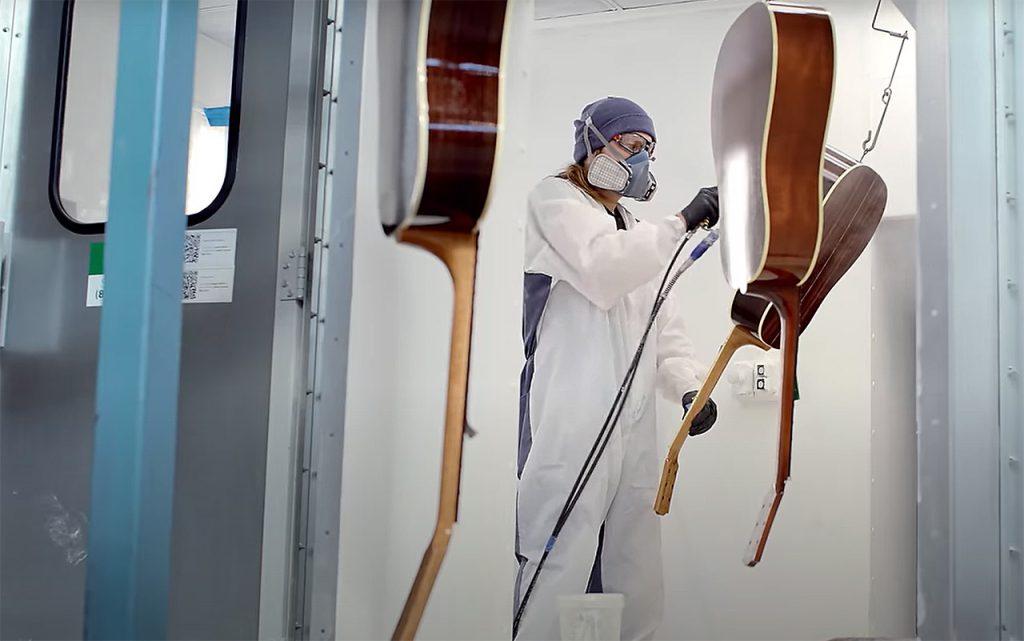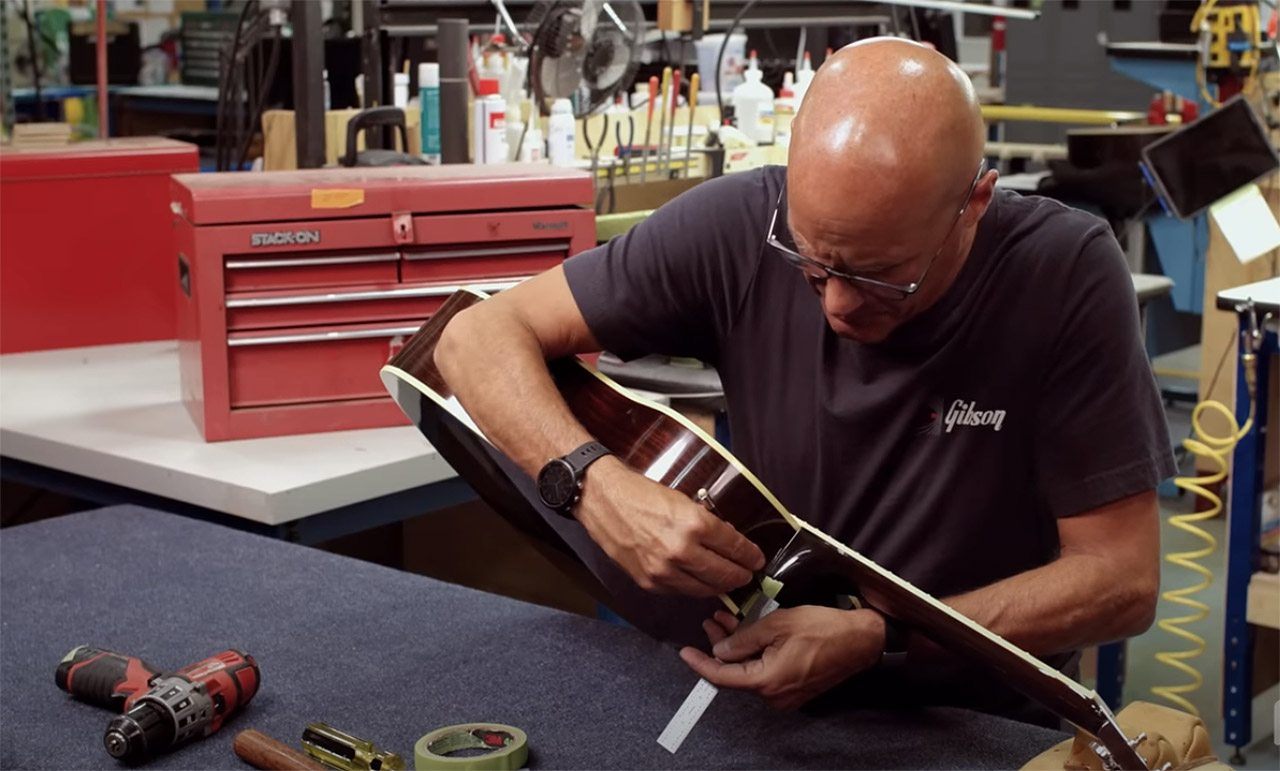Perhaps you’re one of the 16 million people who took up guitar during the pandemic and it’s finally time to do some sprucing up.1 Or perhaps you’ve been playing for a while, and you need a quick maintenance refresher. Whatever your musical journey and how you ended up here, we’re happy to have you.
Regular acoustic guitar maintenance is critical to keeping your instrument sounding and playing correctly.
Much like your car, a guitar can only perform at its best with proper upkeep, tuning, and cleaning. If it ends up neglected, your sound could end up breaking down when you need it most, whether that’s a string breaking or a neck that’s far too bent.
Pour love into your acoustic guitar, and it will thank you with quality sound.
Cleaning and Polishing
Keeping your guitar clean isn’t just for aesthetics. If the fretboard gets gunked up with dirt and oil from your hands, you won’t get the proper resonance or overall sound you’re hoping for. Plus, when you clean your guitar regularly, you might also save yourself a huge, costly repair service in the future.
Cleaning Guide
The first step to keeping your guitar clean is to wash your hands before playing. Similarly, after you use the instrument, you should gently wipe down the body and fretboard with a cloth. This will help remove your natural oils, clear away any small particles that have gotten trapped in the wood, and prevent corrosion of metal acoustic guitar parts.
If your guitar has a finish, you’ll want to use a guitar polish to maintain and protect that shine. Note that some guitars have a satin finish that is less glossy and more porous, making them sensitive to frequent polishing.
Recommended Products
Cotton or microfiber cloths are an essential acoustic guitar care item. Microfiber is a good choice for reducing the risk of scratches.
When shopping for guitar polish, look for options that won’t be too harsh. The gentler the polish, the safer it is for use with different types of finish.
If you were to encounter a nightmare scenario—you’re out at a gig, and someone spills their drink on your guitar—you could use a little soap and warm water. But, for regular maintenance, you should always use gentle, dedicated guitar care products.
String Changing and Maintenance
Changing your acoustic guitar strings can be intimidating for a first-timer, but it’s a crucial part of acoustic guitar maintenance. Gibson Master Luthier Jim DeCola’s guide can teach you how to do it.
When to Change Guitar Strings
Even if a string hasn’t snapped, you’ll know it’s time to change it when:
- It produces a dull, flat sound – This is often due to “metal fatigue,” where a string loses elasticity and becomes hard and brittle over time.
- It’s leaving a greenish residue on your fingertips – This strange phenomenon comes from the oxidation of bronze-based strings.
How to Change Strings
To change a guitar string, turn its tuning knob with your fingers or a winder until the string tension is loose. Then, pop the bridge pin from the bridge and gently remove each one. To restring, you’ll do the same actions in reverse (locking the ball ends of the string with the bridge pin, threading each string through its tuning post, and adjusting string tension), then clip the excess string off the ends with wire cutters.
String Care Tips
Keeping your strings clean, both by washing your hands before playing and giving the strings a quick wipe-down after, is the easiest way to care for your guitar’s strings.

Image: Gibson nitrocellulose lacquer spray booth at the Montana craftory
Humidity and Temperature Control
One of the most crucial considerations when it comes to acoustic guitar care is keeping your instrument safe from the pesky, ever-present threat of humidity.
Environmental Effects
The ideal range in which your guitar should be stored is between 40%-60% Relative Humidity.
Between the extremes of low and high, low relative humidity is the more common problem for wood instruments. If the air is too dry, the wood can shrink and crack, causing structural damage and “string buzz.” On the other hand, too much humidity over a long period of time can swell and warp the wood, dulling the instrument’s sound.
Storage Best Practices
It’s always best to keep your guitar in its case whenever you aren’t using it. This will help with dust and humidity issues, extending its lifespan.
When your guitar is out, avoid leaving it in direct sunlight or in rooms that change temperature dramatically.
Similarly, if you live in an area with fluctuating humidity, you may want to invest in a hygrometer. This handy device is like a thermometer for the level of water in the air. You can even find hygrometers designed to stay in guitar cases.
Regular Check-Ups and Adjustments
When you’re a beginner, it’s perfectly normal just to keep your guitar clean, learn to change out your strings, and leave the rest to a seasoned veteran.
Taking your guitar to a professional once or twice a year is a great way to make sure that more complex issues are addressed promptly.
Importance of Professional Setups
When you pay for a professional setup, you can usually expect:
- Basic tuning and string change as needed
- Acoustic guitar intonation adjustment to keep the pitch accurate across the fretboard
- Lifting or lowering the bridge
- Straightening the neck
- Adjustment of the pickup height for warmth and resonance
The best part of professional setups, though, is how often they can solve problems you didn’t know you had or couldn’t diagnose yourself.
DIY Maintenance
If yearly setups sound like a big investment, you can find a wealth of DIY resources available in the Gibson Gazette.

Image: Gibson J-45 Standard Red Spruce, Exclusive , Tri-Burst
Good Maintenance for Greater Sound
Everyone knows it’s important to have discipline when it comes to guitar lessons and practicing your instrument—discipline in the care of your guitar is just as important.
We know that the start of the journey can be overwhelming, but with these basic acoustic guitar care tips, you’re already well on your way.
Gibson has been a leader among guitar lovers for over a century. We’re passionate about craft, obsessive over quality, and, above all, we love music. Take a look at our website for guitar care tools and more information on all things electric, acoustic, bass, and beyond.
Sources:
- Forbes. Study Shows 16 Million People Learned To Play Guitar During The First Two Years Of The Pandemic. https://www.forbes.com/sites/jesscording/2022/06/24/study-shows-16-million-people-learned-to-play-guitar-during-the-first-two-years-of-the-pandemic/?sh=4751352c5400
- Acoustic Guitar. How Guitar Strings Age—and How to Know When to Change Them. https://acousticguitar.com/how-guitar-strings-age-and-how-to-know-when-to-change-them/
- Condair. Humidity Control for Musical Instruments. https://www.condair.com/m/0/23-745-musical-instruments.pdf

